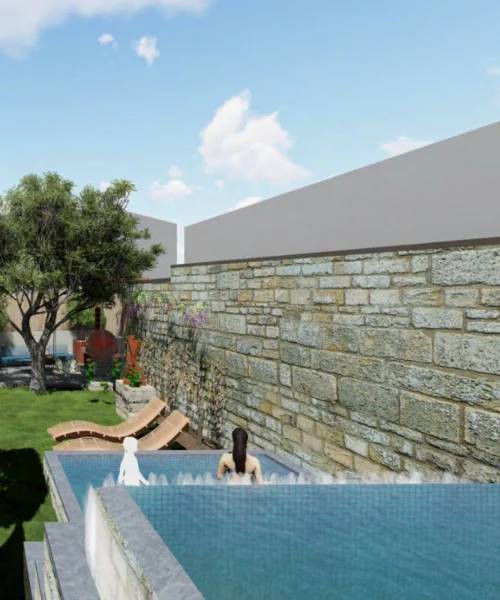When the garden shapes the pool
No two plots are the same. Some are flat and generous. Others seem like leftover corners from a complicated architectural layout. And then there are the narrow strips, the steep slopes, the tiny courtyards squeezed between walls. We’ve worked with all of them.
And that’s why pool shape matters. More than style. More than budget.
Flat ground? You’ve got options
When the land stretches out with no incline and no surprise, it’s tempting to go for the classic rectangle. And honestly, why not? It’s easy to cover. It feels spacious. It allows for proper laps if you’re into swimming. Plus, every piece of kit—cover, roller, bench—fits like it should.
But it’s not just about rectangles. If your garden is square or wide, a Roman or Grecian end softens the geometry. We’ve also seen perfectly symmetrical plots transformed with L-shaped pools, separating swim zones from lounging spaces (no one likes a ball hitting their cocktail).
In gardens over 700 m² (around 7,500 sq ft), a pool of 10 x 5 metres (approximately 32 x 16 ft) often strikes the right balance. But we’ve seen equally successful builds in tighter formats. It’s not a formula. It’s a dialogue with the space.
Small plots need smart moves.
In city gardens, where space is limited and neighbours are close, the pool becomes part architecture, part invention. Mini-pools (under 15 m², or around 160 sq ft) aren’t compromises—they’re deliberate choices. One project in Bordeaux fit snugly into a 5-metre (approx. 16.5 ft) recess between a living wall and a wooden deck. It barely made a splash, but felt like a secret courtyard in Marrakech.
These smaller pools heat faster, need less maintenance, and often feel more luxurious because of their detail. Underwater lighting. Stone surrounds. A compact bench that catches the last rays of evening sun.
Odd shapes? Think free-form
One client in Mallorca had a triangular back garden. The only sun hit the corner between two old stone walls. We sketched a free-form pool that wrapped around the constraints—almost like a water sculpture tucked between shrubs and stone. It wasn’t what they imagined at first. But when they saw the reflection of the olive tree in the curved waterline, they didn’t want anything else.
This kind of design works when the terrain doesn’t play by the rules. Think curved, tapered, asymmetrical plots. Add planting close to the edge, and it feels like a spring-fed basin that was always there.
Morana Expert Tips👇
Start with what you have. The shape of your garden isn’t a constraint — it’s the beginning of the design. Don’t try to force a standard pool into a space that deserves better. Let the lines emerge from the way the sun moves, from the angles that feel natural when you stand outside barefoot.
Think in volumes, not just in surface. A long narrow pool might offer more pleasure than a square. A small plunge pool, well-placed, can feel more generous than a big one in the wrong spot. And always—always—walk the land before you draw.
Every garden deserves a tailored approach.
If you’re ready to begin the dialogue, we’ll guide you through the first step.
Slopes are not the enemy
Actually, they’re often an opportunity. With elevation comes perspective. And with perspective comes the potential for something that goes beyond utility.
We’ve worked on hillside plots where the terrain dropped nearly two metres (approx. 6.5 ft) between house and garden edge. Instead of fighting it, we worked with it. That’s where the infinity pool makes sense.
It’s not just about the edge vanishing. It’s the feeling. That moment when someone walks out to the terrace and the water seems to fall straight into the valley. Or when the surface picks up the colour of the sky and stretches it toward the view.
For sloping ground, the pool isn’t just part of the garden—it becomes part of the horizon.
When digging's not an option
On rocky or flood-prone sites, we often turn to semi-inground or above-ground builds. Forget the inflatable clichés. We’re talking clean lines, dark timber cladding, and low retaining walls that double as benches.
It’s fast. And if done right, it doesn’t feel like a compromise. One build in Porto used a natural stone structure that worked with the existing walls of a narrow urban plot. As the sun set, the reflections climbed the façades around it, turning the water into a sheet of blue glass.
It just takes a different way of thinking — access, plumbing, filtration. But it works.

“The water isn't shaped by the pool — it's shaped by the garden.”
Understanding the terrain changes everything
You don’t need a perfect garden to have a great pool. But understanding your space changes everything.
We always start with the terrain—its dimensions, its constraints, the way the light moves across it. From there, the shape almost suggests itself.
Curious how we adapt shapes to real constraints?
→ Explore our tailored pool design approach
More than a shape — A feeling
Sometimes, it’s a long corridor. Sometimes, it’s a curved recess. Once, it was a square cut into volcanic rock.
What matters isn’t just what you see on a sketch. It’s what you feel when it’s built.
Not every shape fits every site. But there’s always one that does.
